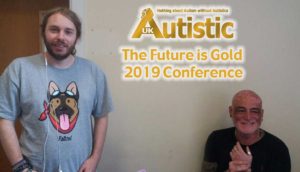 We took some notes from the conference that took place yesterday that we wanted to share.
We took some notes from the conference that took place yesterday that we wanted to share.
I should express that it is paraphrased and therefore has been put through the lens of my own interpretation, so it may not reflect 100% the intended meaning of the speakers.
Associate to Head of Film Society
The Future is Gold – Autism Conference
Jamie and Lion – The Future of Technology
Any sufficiently advanced technology is indistinguishable from magic
Jamie is a Senior Research Engineer at the BBC, the goal of which is to improve accessibility for disabled people.
Impairment + Environment = Disability
I.e. we disable people by creating barriers in the environment; impairment is not inherently disabling.
What technology (or magic) can we use to remove these barriers?
These barriers can relate to environment (around us), automation (assisting us), and communication (connecting us).
Environment – ‘Things we do, before we do any things.’
Spoons. Each day we have a number of spoons that we can spend on activities (it may require two spoons to provide food for the day, three spoons on safety, and four spoons on communication – but if you only have eight spoons in one day, this creates a problem, as you don’t have enough spoons to cope with activities for the day), and this number of spoons can vary day-to-day.
By implementing changes to the environment, we could reduce the number of spoons it takes to carry out tasks. For example, introducing smart appliances to cook food will reduce the number of spoons it requires to prepare food. Similarly, installing a smart alarm will reduce the number of spoons required to ensure safety.
A good example of using the magic of technology to thrive is through the use of VR. VR can provide a portable sensory room for people to use to relax, or build and explore worlds outside of our reality, which can be stressful and uncontrollable
Automation – ‘Reducing demands.’
Abilities – list of things I can do
Capabilities – list of things I can do today
Capacity – how many of those things I can do today
The magic of automation can be used to reduce the number of things that need to be done, so that we can do more that we want to, likewise, automating transportation (Alexa, take me to a shop that sells Rolos), and services (Alexa, book me a haircut) will also reduce the demands required of us so that we can do more.
Communication – ‘Conveying meaning and co-ordinating action.’
Communication and speech are different.
‘The Communication Mountain’ describes that speech lies at the top of a mountain, and it is the job of communication to reach the top of the mountain – some days, when things are easier and needs are met, speech is easily attainable, but on other days (perhaps days with fewer spoons) communication that can be made without the use of speech will be preferred.
Shortcuts to communication are currently available, such as speech synthesisers on Smart Watches (to allow for effective communication without the requirement for speech), or messaging/posting apps.
Re-packaging, or re-interpreting (in the BBC, this comes in the form of translating speech into subtitles and sign language), allows for information to be more freely accessible for people with differing communication needs.
Steve Silberman, author of Neurotribes
The early ideas for the book came from writing an article for Wired Magazine entitled Geek Syndrome.
Over the course of his career, Steve came into contact with more and more professionals who were Autistic, or who had Autistic family members. Around the time that Steve’s research had come to a head and his research and findings were to be posted, 9/11 took place, and as a result, the article hit the backburners. In the years following, Autism was theorised to be caused by a menagerie of factors, the biggest of which being silicon in water supplies (hence the large number of Autistic people living and working in Silicon Valley, *GASP*), and the the most pervasive, being vaccines.
Steve’s research challenged his understanding a lot of the theories and models that had been suggested up to that point to try to explain Autism, and was alienated from those models as a result. When researching Neurotribes, Steve attended an ‘Autism retreat’ with a bus-full of Autistic people (bearing in mind, up to this point, the general consensus was that Autistic people would never have friends or social connections and never arise to any conceivably successful job prospects), all of whom appeared happy, sociable, and thoroughly enjoying eachother’s company.
Of course, this had completely subverted the ‘textbook’ description of Autistic people and given a true lived experience of neurodiverse lifestyle and how neurotypicality enforces unnecessary social rules on individuals. As a neurotypical on a retreat with an Autistic group, over the course of the holiday, Steve had un-learned many of these social rules and acclimatised to a communication style that he (and the rest of the neurotypical world) was unaccustomed to.
Up to this point, Leo Kanner, the psychiatrist who ‘discovered’ Autism, had theorised (among the multitude of other theories he spouted) that it was caused by refrigerator parents (cold, unloving parents), and disproportionately affected white, middle-class, ambitious, studious individuals, A.K.A. white, middle-class, ambitious, studious individuals, the only population who could afford to have access to Leo Kanner himself.
Steve spoke at length about the role of Hans Aspergers in the emergence of Autism, as well as the recent controversy surround his supposed Nazi associations and will be discussing this topic in forthcoming writings, sharing his depth of knowledge and unique insights into what is a thoroughly interesting and controversial debate.
Jerry Rothwell – Filmmaker behind The Reason I Jump
The Reason I Jump was originally a book written by a 12 year old non-verbal Autistic boy named Naoki Higashida, who, when it came to the film being made (at the age of 23), expressed that he did not want it to be biographical, so that he did not come across as ‘the voice for Autistic people’.
Naoki is Japanese and uses a piece of paper with letters of the alphabet that he can point at to communicate words
The film covers five main themes:
• Hyperfocus
• Sensory overload
• Communication
• Stigma
• As I am
The film follows the lives of young people living in different cultures (UK, US, Indian and African) relating to these themes, expressing how they live their lives and the challenges they face.
Share This Post:







It was a privilege to be there
It certainly was a privilege to be there. Amazing speakers, incredibly educational and interesting. Also do you have any notes on Lukes talk?
Hi Jessie,
Luke wanted to add a few bits to the notes I took before I post them on the website, so we should have those up soon.
Hope this helps
Absolutely, thank you Ren!
Your notes are fab, thank you for sharing them with everyone. There was so much to record I don’t know how you’ve managed it.
Well done Ren
Many thanks
Linda